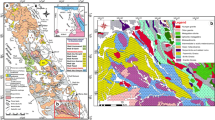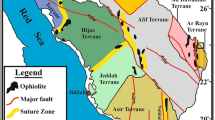Abstract
In this paper, we have analysed active and passive earth observation data for identifying the different geomorphic sub-provinces associated with coastal and fluvial geomorphic processes in the south-western part of Bengal Basin. For this purpose, variations in the spectral response of these sub-provinces in IRS P6 LISS III data are enhanced using principal component (PC) and independent component (IC) methods to spatially delineate the geomorphic sub-provinces and associated Quaternary sediments. It has been observed that the false colour composite derived using IC (first, second and third ICs) are effective in enhancing fluvial sub-provinces, while IC band 4, band 3 and band 2 are suitable to delineate coastal sub-provinces. On the other hand, PC composite derived using band 4, band 3 and band 1 are suitable to delineate different Quaternary sediments deposited within the spatial extent of geomorphic sub-provinces. Fused image enhanced products of IRS (Indian Remote Sensing Satellite) LISS III band and ALOS (Advanced Land Observing Satellite) PALSAR (Phased Array L-band Synthetic Aperture Radar) polarisation bands are used to supplement and complement the variations observed for each geomorphic province in optical data as radar interactions are sensitive to variation in moisture and surface cover. Although there is a strong synergy between the spatial extent of geomorphic sub-provinces and the Quaternary units in terms of spatial disposition, different Quaternary units are also found within the same geomorphic province. Therefore, we have segmented each geomorphic sub-provinces based on the spatial extent of the different Quaternary deposits to identify few geoenvironmental (termed here as geomorpho-environmental) zones. In this regard, eleven zones are identified. Each zone has been characterised based on geomorphic stability, potentiality for agriculture practice, scope for urban development and reclamation. These geoenvironmental zones may provide important input to planners.










Similar content being viewed by others
References
Akter J, Sarkar MH, Popescu I, Roelvink D (2015) Evolution of the Bengal Delta and its prevailing processes. J Coast Res (in press). doi:10.2112/JCOASTRES-D-14-00232.1
Alam M, Alam MM, Curray JR, Chowdhury MLR, Gani MR (2003) An overview of the sedimentary geology of the Bengal basin in relation to the regional tectonic framework and basin-fill history. Sediment Geol 155:179–208
Alaska Satellite Facility (2016) ALOS-1 phased array type L-band synthetic aperture radar. https://www.asf.alaska.edu/sar-data/palsar/about-palsar/
Allison MA, Khan SR, Goodbred SL, Kuehl SA (2003) Stratigraphic evolution of the late Holocene Ganges–Brahmaputra lower delta plain. Sediment Geol 155:317–342
Bandyopadhyay S, Das S, Kar NS (2015) Discussion: 'changing river courses in the western part of the Ganga–Brahmaputra delta' by Kalyan Rudra (2014), Geomorphology 227, 87–100. Geomorphology 250:442–453
Bhattacharya A, Banerjee SN (1979) Quaternary geology and geomorphology of the Ajay Bhagirathi valley, Birbhum and Mursidabad districts, West Bengal. Indian J Earth Sci 6(1):91–102
Cadavid AC, Lawrence JK, Ruzmaikin A (2007) Principal components and independent component analysis of solar and space data. Solar Phys 248(2):247–261
Cetin M, Musaoglu N (2009) Merging hyper spectral and panchromatic image data: qualitative and quantitative analysis. Int J Remote Sens 30(7):1779–1804
Chitade AZ, Katiyar SK (2012) Multiresolution and multispectral data fusion using discrete wavelet transform with IRS images: cartosat_1, IRS LISS III and LISS IV. J Indian Soc Remote Sens 40(1):121–128
Coleman JM (1981) Deltas: processes of deposition and models of exploration, 2nd edn. Burgess, Minneapolis
Crósta AP, De Souza Filho CR, Azevedo F, Brodie C (2003) Targeting key alteration minerals in epithermal deposits in Patagonia, Argentina, using ASTER imagery and principal component analysis. Int J Remote Sens 24(21):4233–4240
Garzelli A (2002) Possibilities and limitations of the use of wavelets in image fusion. In: Geoscience and remote sensing symposium, IGARSS ‘02. 2002 IEEE international (1), pp 66–68. doi:10.1109/IGARSS.2002.1024943
Gomez C, Le Borgne H, Allemand P, Delacourt C, Ledru P (2007) N-FindR method versus independent component analysis for lithological identification in hyperspectral imagery. Int J Remote Sens 28(23):5315–5338
Goodbred SL, Kuehl SA (2000) The significance of large sediment supply, active tectonism, and eustasy of margin sequence development: late quaternary stratigraphy and evolution of the Ganges-Brahmaputra delta. Sediment Geol 133:227–248
Goodbred SL, Kuehl SA, Steckler MS, Sarkar MH (2003) Controls on facies distribution and stratigraphic preservation in the Ganges-Brahmaputra delta sequence. Sediment Geol 155:301–316
Guha A, Kumar KV, Kamaraju MVV (2008) Influences of look angle and look direction of space borne SAR sensor in geological feature delineation—a case study in meta sedimentary terrain of Kurnool Group of rocks, Andhra Pradesh. Curr Sci 95:99–104
Guha A, Kumar KV, Kamaraju MVV (2009) Potentials of alternate polarization of Envisat ASAR Data in geological mapping of Proterozoic metasedimentary rocks of Kurnool Basin, Kurnool, Andhra Pradesh. J Geol Soc India 73:268–272
Guha A, Kumar KV, Lesslie A (2009a) Satellite-based geomorphological mapping for urban planning and development—a case study for Korba City Chhattisgarh. Curr Sci 97(12):1760–1765
Guha A, Kumar KV, Kamaraju MVV (2009b) Potentials of alternate polarization of Envisat ASAR data in geological mapping of Proterozoic metasedimentary rocks of Kurnool Basin, Kurnool, Andhra Pradesh. J Geol Soc India 73:268–272
Guha A, Ghosh D, Kumar VK, Majumdar R (2013) Potential of polarimetric Radarsat-2 data in geological mapping—a case study in parts of Dharwar craton, India. Int J Remote Sens 34(6):1893–1904
Haack BN, Herold ND, Bechdol MA (2000) Radar and optical data integration for land-use/land-cover mapping. Photogramm Eng Remote Sens 66(6):709–716
Han SS, Li HT, Gu HY (2008) The study on image fusion for high spatial resolution remote sensing images. In: Proceedings of XXI ISPRS congress, commission vii, the international archives of the photogrammetry, Remote sensing and spatial information sciences (ISPRS 2008), 3–11 July 2008, Beijing, China, XXXVII (B7), pp 1159–1164
IRS Data products (2016). http://www.nrsc.gov.in/IRS_Data_Products?q=Earth_Observation_Missions. Accessed on 11 Feb 2016
Joseph J (2005) Fundamentals of Remote Sensing. University Press, Nancy, p 486
Kenea NH, Haenisch H (1996) Principal component analyses for lithologic and alternation mappings: examples from the Red sea hills, Sudan Int Arch Photogramm Remote Sens. Vienna 31:271–275
Kuehl SA, Allison MA, Goodbred SL, Kudrass H (2005) The Ganges-Brahmaputra delta. In: Gosian L, Bhattacharya J (eds) River deltas: concepts, models, and examples Special Publication 83. SEPM, Tulsa, pp 413–434
Kuehl SA, Levy BM, Moore WS Allison MA (1997) Sub-aqueous delta of the Ganga-Bramhaputra river systems. Mar Geol 144:81-96
Lindsay JF, Holiday DW, Hulbert AG (1991) Sequence stratigraphy and the evolution of the Ganges-Brahmaputra complex. Am Assoc Pet Geol Bull 75:1233–1254
Lu D, Batistella M, Li G, Moran E, Hetrick S, Freitas CDC, Dutra LV, Sant’Anna SJS (2012) Land use/cover classification in the Brazilian amazon using satellite images. Pesqui Agropecu Bras 47(9):1185–1208
Mukherjee A, Fryar AE, Thomas WA (2009) Geologic, geomorphic and hydrologic framework and evolution of the Bengal basin, India and Bangladesh. J Asian Earth Sci 34(3):227–244
Munyati C (2004) Use of Principal Component Analysis (PCA) of Remote Sensing Images in Wetland Change Detection on the Kafue Flats, Zambia. Geocarto Int 19(3):11–22
Niyogi D (1975) Quaternary geology of the coastal plain in West Bengal and Orissa. Indian J Earth Sci 2:51–61
NRSC (2016) Bhuvan Bhujal. http://bhuvan-noeda.nrsc.gov.in/projects/gwis/gwis.php. Accessed 03 March 2016
Pal SK, Majumdar TJ, Bhattacharya AK (2007) ERS-2 SAR and IRS-1C LISS III data fusion: a PCA approach to improve remote sensing base d geological interpretation. ISPRS J Photogramm Remote Sens 61(5):281–297
Pye K, Blott SJ (2008) Decadal-scale variation in dune erosion and accretion rates: an investigation of the significance of changing storm tide frequency and magnitude on the Sefton coast, UK. Geomorphology 102(3–4):652–666
Rahman MM, Moran MS, Thoma DP, Bryant R, Collins CDH, Jackson T, Tischler M (2008) Mapping surface roughness and soil moisture using multi-angle radar imagery without ancillary data. Remote Sens Environ 112:391–402. doi:10.1016/j.rse.2006.10.026
Ramadan TM, Nasr AH, Mahmood A (2006) Integration of Radarsat-1 and landsat TM images for mineral exploration in East Oweinat district, south western desert, Egypt. In: ISPRS Commission VII Mid-term Symposium, The Netherlands, pp 244–249
Roy AB, Chatterjee A (2015) Tectonic framework and evolutionary history of the Bengal Basin in the Indian subcontinent. Curr Sci 109(2):271–279
Rudra K (2014) Changing river courses in the western part of the Ganga-Brahmaputra delta. Geomorphology 227:87–100
Saygin A, Fusun BS, Filiz S, Manfred E (2014) A comparative data-fusion analysis of multi-sensor satellite images. Int J Digit Earth 7(8):671–687. doi:10.1080/17538947.2012.748846
Singh LP, Parkash B, Singhvi AK (1998) Evolution of the Lower Gangetic plain landforms and soils in West Bengal, India. Catena 33:75–104
Singh S, Guha A, Kumar KV, Bardhan S, Lesslie A, Ravi Kumar MV, Chatterjee A (2015) Satellite based mapping and morphogenetic analysis of the landforms in the tertiary fold belts of parts of Tripura, India. Geocarto Int 30(9):1–17
Sinha R (1996) Channel avulsion and floodplain structure in the Gandak–Kosi interfan, north Bihar plains, India. Z Geomorphol Suppl 103:249–268
Sinha R, Jain V, Babu GP, Ghosh S (2005) Geomorphic characterization and diversity of the fluvial systems of the gangetic plains. Geomorphology 70(3–4):207–225
Soljestrom PA, Moreno A, Vikgren K, Caceres LM (1997) The application of selective principal component analysis (SPCA) to the thematic mapper (TM) image for the recognition of geomorphic features configuration. Int J Remote Sens 18(18):3843–3852
Tsai VJD (2004) Evaluation of multiresolution image fusion algorithms. In: Proceedings of IEEE 2004 geoscience and remote sensing symposium (IGARSS ‘04), 20–24 September 2004, Anchorage, AK. doi: 10.1109/IGARSS.2004.1369104
Umitsu M (1993) Late quaternary sedimentary environments and landforms in the Ganges Delta. Sediment Geol 83:177–186
Vaidyanadhan R, Ghosh RN (1993) Quaternary of the east coast of India. Curr Sci 64(11–12):804–816
Woodhouse IH (2005) Introduction to microwave remote sensing. CRC Press, Boca Raton, p 400
Woodroffe CD (2002) Coasts: form, process and evolution. Cambridge University Press, Cambridge
Zhang Y (1999) A new merging method and its spectral and spatial effects. Int J Remote Sens 20:2003–2014
Acknowledgement
Authors are grateful to Director, NRSC, for his encouragement and guidance. Authors are also grateful to Deputy Director, RSA, for his keen interest on the progress of the work and support to carry out the work.
Funding was provided by Indian Space Research Organisation, Department of Space (IN).
Author information
Authors and Affiliations
Corresponding author
Rights and permissions
About this article
Cite this article
Singh, S., Guha, A., Seshadri, K. et al. Earth observation-based approach for delineating geomorphology-guided geoenvironmental zones and its utility in regional planning: an analysis in parts of Bengal Basin, West Bengal, India. Environ Earth Sci 76, 109 (2017). https://doi.org/10.1007/s12665-016-6323-9
Received:
Accepted:
Published:
DOI: https://doi.org/10.1007/s12665-016-6323-9




